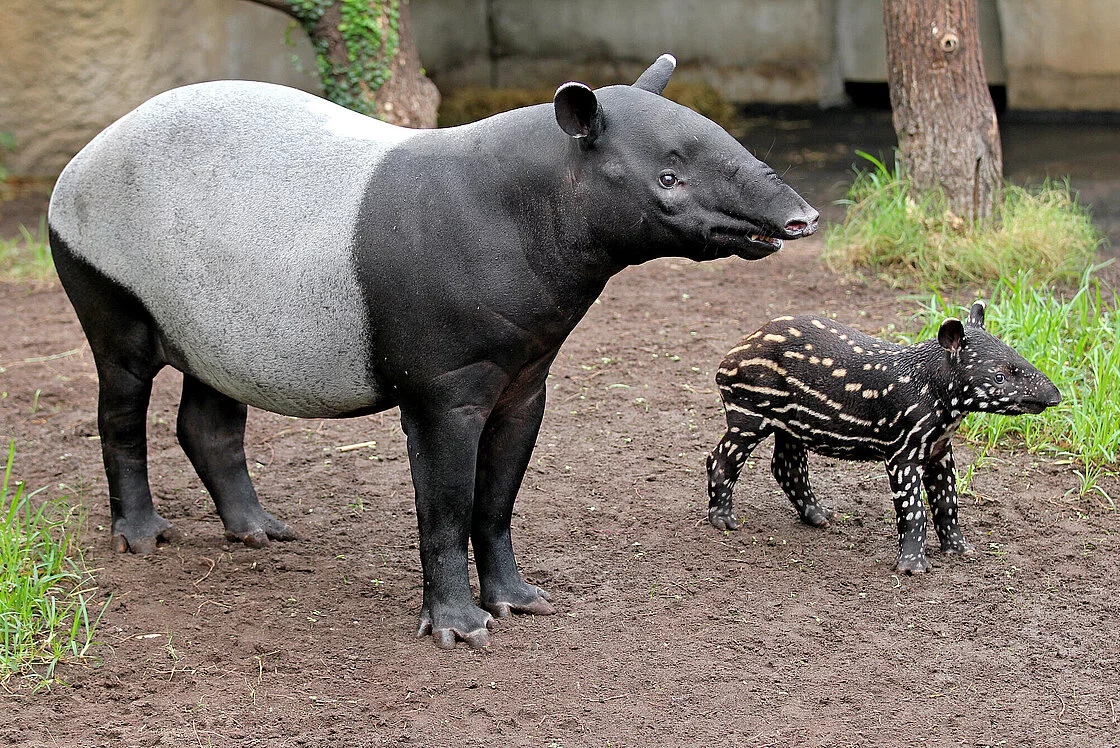
The Malayan tapir, also known as the Asian tapir, is a fascinating and unique mammal that inhabits the rainforests of Southeast Asia. With its distinctive black and white coloration, herbivorous diet, and solitary nature, the Malayan tapir stands out as the largest of the five tapir species. From their prehensile trunk-like nose to their gentle demeanor, these endangered creatures play a vital role in their forest ecosystems. Let’s delve deeper into the world of the Malayan tapir and uncover some intriguing facts about this remarkable species.
The Malayan tapir, also known as the Asian tapir, holds the title of being the largest of the five tapir species. These herbivorous mammals are known for their unique appearance, with a striking black and white coloration that aids in their camouflage within the dense forests of Southeast Asia. Their large size and distinctive markings make them a fascinating species to observe in their natural habitat.
Tapirs are strict herbivores, with the Malayan tapir specifically feeding on a diet of leaves, twigs, and fruits. Their herbivorous nature plays a crucial role in the ecosystem, as they help in seed dispersal and contribute to the overall health of the forest they inhabit. This dietary preference also influences their behavior and habitat choices, as they seek out areas abundant in vegetation to sustain themselves.
The black and white coloration of the Malayan tapir is a key adaptation that allows them to blend seamlessly into their forest surroundings. This natural camouflage helps them avoid predators and navigate their environment with greater ease. Their coloration, combined with their size and unique features, makes them a visually striking and memorable species within the animal kingdom.
Malayan tapirs are known for their exceptional swimming abilities, often found in rivers and streams within their forest habitat. Their proficiency in water serves various purposes, from cooling off in hot climates to accessing food sources that may be near water bodies. Their aquatic skills showcase the adaptability of these creatures to different environments and highlight their resourcefulness in the wild.
The prehensile trunk-like nose of the Malayan tapir is a remarkable feature that sets them apart from other mammals. This specialized appendage allows them to grasp leaves and food items with precision, showcasing their evolutionary adaptations for efficient feeding. The tapir’s nose serves as a versatile tool for foraging and interacting with their environment, demonstrating the ingenuity of nature’s designs.
With a gestation period of approximately 13 months, Malayan tapirs invest significant time and energy into the reproduction and care of their offspring. The lengthy gestation period reflects the tapir’s commitment to ensuring the survival of their species, as they carefully nurture and protect their young. The birth of a tapir calf marks a significant milestone in the life cycle of these majestic creatures.
Malayan tapir calves are born with a distinctive coat pattern resembling watermelon stripes, a unique trait that aids in their survival. This camouflaged appearance helps them blend into their forest surroundings and evade potential predators during their vulnerable early stages of life. The intricate markings of tapir calves serve as a natural defense mechanism, showcasing the beauty and functionality of evolutionary adaptations in the animal kingdom.
Adult Malayan tapirs can weigh between 500 to 800 pounds (227 to 363 kilograms), making them a substantial presence in their ecosystem. Their size reflects their position as one of the largest herbivores in their habitat, influencing their role in shaping the environment around them. The tapir’s weight is a testament to their strength and resilience as they navigate the challenges of survival in the wild.
Malayan tapirs can reach impressive lengths of up to 8 feet (2.4 meters) and stand around 3 to 4 feet (1 to 1.2 meters) tall at the shoulder. These dimensions showcase the physical stature of these animals and highlight their imposing presence in their natural habitat. The tapir’s size plays a crucial role in various aspects of their behavior, from foraging for food to navigating through the dense vegetation of the forest.
The lifespan of a Malayan tapir in the wild ranges from 25 to 30 years, reflecting the longevity and resilience of these magnificent creatures. Their ability to survive and thrive in their natural environment for several decades speaks to their adaptability and evolutionary success as a species. The tapir’s lifespan is a testament to their ability to withstand the challenges of their habitat and contribute to the intricate balance of the ecosystem.
The endangered status of the Malayan tapir is a concerning reality, with habitat loss and hunting posing significant threats to their population. Conservation efforts are crucial to safeguarding these majestic creatures and ensuring their survival in the wild. The challenges they face highlight the importance of raising awareness about the plight of endangered species and taking action to protect their habitats.
The natural habitat of the Malayan tapir includes the rainforests of Southeast Asia, specifically countries like Malaysia, Indonesia, and Thailand. These lush and diverse ecosystems provide essential resources for the tapirs to thrive, emphasizing the interconnected relationship between the species and their environment. Preserving these habitats is vital for the long-term well-being of the Malayan tapir population.
Being the national animal of Malaysia, the Malayan tapir holds cultural significance and symbolic value in the country. This recognition highlights the tapir’s importance as a representative of Malaysia’s rich biodiversity and natural heritage. Celebrating and protecting the national animal serves as a reminder of the need to conserve and cherish the unique wildlife that inhabits the region.
The solitary nature of Malayan tapirs reflects their independent lifestyle, with individuals typically coming together only during the breeding season. This behavior pattern underscores the tapir’s self-sufficiency and adaptability in navigating their environment. Understanding their solitary habits provides insights into their social dynamics and reproductive strategies in the wild.
The close kinship of the Malayan tapir with other tapir species found in Central and South America highlights their shared evolutionary history and genetic connections. Despite geographical distances, tapirs across different regions exhibit similar traits and behaviors, showcasing the enduring legacy of these ancient mammals. Exploring their genetic relationships offers valuable insights into the evolutionary pathways of tapirs worldwide.
Tapirs play a vital role in forest ecosystems by dispersing seeds through their droppings, contributing to the regeneration and diversity of plant species. This ecological function underscores the importance of tapirs as key players in maintaining the health and balance of their habitats. The symbiotic relationship between tapirs and plants illustrates the intricate web of interactions that sustain biodiversity in tropical forests.
The keen sense of smell possessed by the Malayan tapir enhances their ability to navigate and locate food sources in their dense forest habitat. This olfactory prowess is a crucial adaptation that enables tapirs to detect predators, identify suitable foraging areas, and communicate with other individuals. Their sense of smell serves as a vital tool for survival in the complex and dynamic environment of the rainforest.
Tapirs’ status as living fossils stems from their ancient lineage and evolutionary history dating back millions of years. Their unique characteristics and genetic makeup provide valuable insights into the evolutionary processes that have shaped mammalian diversity over time. Studying tapirs as living fossils offers a window into the past and sheds light on the adaptations that have allowed them to persist through changing environments.
The activity patterns of Malayan tapirs, with peak activity during the early morning and late afternoon hours, reflect their diurnal lifestyle and behavioral rhythms. This behavioral adaptation aligns with their foraging patterns, social interactions, and predator avoidance strategies in the wild. Understanding their activity cycles offers valuable insights into the daily lives and habits of these fascinating creatures.
The gentle and docile nature of the Malayan tapir endears them to zoo visitors and wildlife enthusiasts, showcasing their peaceful demeanor and non-aggressive behavior. Their calm temperament makes them popular attractions in zoos and conservation centers, allowing people to observe and appreciate these magnificent animals up close. The tapir’s gentle disposition highlights their unique personality traits and contributes to their charm as an iconic species of the rainforest.
Tapirs communicate through various vocalizations, including whistles, squeaks, and snorts, which serve as important forms of social interaction and communication within their species. These vocal cues convey messages related to mating, territorial disputes, and group cohesion, highlighting the diverse ways in which tapirs communicate with one another.
The conservation status of the Malayan tapir is classified as Endangered by the IUCN, underscoring the urgent need for conservation efforts to protect this vulnerable species. Recognizing the tapir’s endangered status raises awareness about the threats they face and the importance of preserving their habitats to ensure their long-term survival. Collaborative conservation initiatives are essential in safeguarding the future of the Malayan tapir population.
Tapirs are crucial umbrella species, playing a pivotal role in ecosystem conservation by serving as flagship species for broader conservation efforts. Protecting tapir habitats benefits a wide range of other plant and animal species that share the same ecosystem, highlighting the interconnected nature of biodiversity conservation. By focusing on tapir conservation, conservationists can address broader environmental challenges and safeguard the overall health of the ecosystem.
The distinctive coloration of the Malayan tapir helps protect them from predators by breaking up their outline in the dappled forest light, providing them with effective camouflage in their natural habitat. This unique color pattern serves as a form of visual defense, allowing tapirs to blend seamlessly into their surroundings and avoid detection by potential threats. Their cryptic coloration showcases the evolutionary adaptations that enable tapirs to thrive in their forest environment.
The scientific name of the Malayan tapir is Tapirus indicus, reflecting their taxonomic classification and genetic relationship to other tapir species. Scientific names provide a standardized way to identify and categorize organisms based on their evolutionary history and biological characteristics. Understanding the scientific name of the Malayan tapir offers insights into their genetic lineage and evolutionary connections within the broader context of mammalian diversity.
Malayan Tapir FAQs: Unveiling the Enigma of the Rainforest
The Malayan tapir, the largest tapir species in Asia, is a captivating creature shrouded in rainforest mystery. Here are some FAQs to illuminate this fascinating animal:
1. What does a Malayan tapir look like?
Imagine a black and white tuxedo worn by a giant, barrel-shaped herbivore. That’s the Malayan tapir in a nutshell! They have a black back, head, and legs, with a distinct white or grayish-white saddle covering their midsection. Their most remarkable feature is a short, prehensile snout resembling a small trunk. This flexible nose allows them to grab leaves and fruits, and even act as a snorkel when they go underwater. Fun fact: They have four toes on their front feet and three on their back feet!
2. How big are Malayan tapirs?
These gentle giants are no slouches! They can grow up to 6 to 8 feet (1.8-2.4 meters) long and weigh a whopping 550 to 704 pounds (250-320 kg). Females are generally larger than males.
3. Where do Malayan tapirs live?
The Malayan tapir calls the lush rainforests of Southeast Asia home, particularly in countries like Malaysia, Thailand, Myanmar, and Sumatra. They prefer dense forests with low-lying vegetation and plenty of water sources for swimming and cooling off.
4. What do Malayan tapirs eat?
Malayan tapirs are herbivores, meaning they munch on plant material. Their diet consists mainly of leaves, shoots, fruits, and aquatic plants. Their flexible snouts come in handy for reaching for tasty leaves on low-lying shrubs and aquatic vegetation.
5. How do Malayan tapirs behave?
These solitary creatures are primarily nocturnal, meaning they are most active at night. They spend their days hidden in dense vegetation, emerging under the cover of darkness to forage and explore their territory. They are excellent swimmers and use rivers and streams for cooling down, escaping predators, and even traveling between different forest patches.
6. How do Malayan tapirs reproduce?
Malayan tapirs are not very social animals, but they do come together to mate. Mating season typically occurs between April and June. After a gestation period of around 395 days, a single calf (twins are rare) is born. The calf has a unique coat of brown hair with white stripes and spots, providing camouflage in the forest undergrowth. The mother cares for her young for up to one year, teaching them foraging skills and survival techniques.
7. Are Malayan tapirs endangered?
Sadly, yes. The IUCN Red List classifies the Malayan tapir as “Endangered.” Habitat loss due to deforestation, poaching for their meat and skin, and road accidents threaten their survival. Conservation efforts are underway to protect remaining populations and their rainforest habitat.
8. What can we do to help Malayan tapirs?
There are several ways you can contribute to the conservation of Malayan tapirs:
- Support organizations working to protect rainforests in Southeast Asia.
- Choose sustainable products that don’t contribute to deforestation.
- Raise awareness about the plight of the Malayan tapir and the importance of rainforest conservation.
- Reduce your consumption of meat, as habitat loss is often linked to agricultural expansion for livestock.
By understanding and appreciating these fascinating creatures, we can work together to ensure their survival for future generations.









